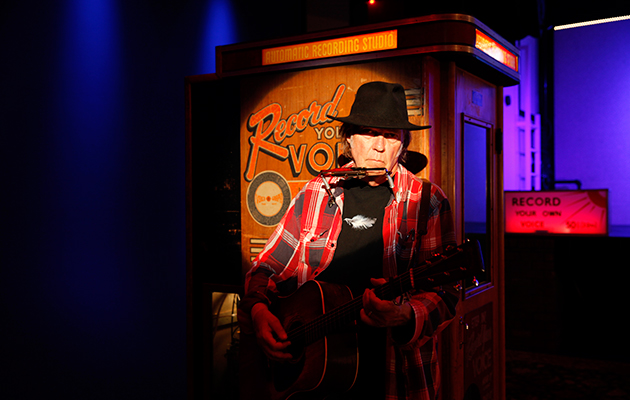Like most things, Poncho Sampedro has a view on Pono. The Crazy Horse guitarist remembers his first exposure to the system one day at his home in Hawaii. “Neil has a place not that far from me here,” he begins. “I was into this whole natural farming thing, this natural farmer guru was coming by my house and I was really nervous. I called Neil up and I said, ‘Neil, would you come over here and give me a little support.’ So he hung with me while this guy, Master Cho, was here. His whole family came and they checked it out and it was a big deal, then they all left. We sat on the couch, Neil and I, talking. That’s when he first started to sell me Pono. He got up and started going, ‘So I walked into Warner Bros, here’s the sales pitch I gave them…’ He pretended he had a blackboard and everything, and I said, ‘Neil, man, that sounds great. But I haven’t listened to a record in probably 20 years.’ After that, he never really talked to me about it again.”
Bruce Botnick, meanwhile, has an understandably different perspective on Young’s high-resolution audio service. Botnick – co-producer of Love’s Forever Changes and a mainstay of many Doors albums – first worked with Young on 1967’s Buffalo Springfield Again. “We stayed in touch,” he explains. “I’d go to some of his concerts. We’d hang, we’d talk and we’d catch up. Three years ago, when he took the Buffalo Springfield reunion on the road, he played a concert near us in Santa Barbara. I went to the show, and Neil said, ‘Can you come backstage afterwards?’ He wanted to show me the prototype for Pono. At that time, it was in Lincvolt, his special Lincoln convertible. That said, it was an astonishingly great speaker system and amplifiers, and he had a prototype – not the one we hold in our hands today, but electronically, the concept – in place, and he was able to demonstrate it.” Botnick recalls Young playing him Aretha Franklin on his new system. Since April this year, Botnick has worked for Pono as VP of Content Acquisition, liaising with record labels. He arrived at the company after Young debuted the system at South By South West in March, but is agreeably confident about the system’s prospects: “They started the Kickstarter appeal to try and raise about seven- or eight-hundred thousand dollars, and instead raised $6.8 million in an incredibly short period of time. You know, we never lose sight of the fact that it is Neil’s concept, from the beginning, and he’s very instrumental. I hate to use Steve Jobs as an analogy, but Steve was a visionary. And Neil, in his own way, is a visionary, too.”
As persuasive as Botnick sounds, Pono is still an unknown quantity; albeit one with significant support. The Kickstarter site, for instance, offered the chance to sign up for Artist Signature Series PonoPlayers, limited to 500 each and costing $400 a pop, featuring artists like Tom Petty, Elton John, James Taylor, ZZ Top, Pearl Jam and CSN. Essentially, Pono will give you the opportunity to buy better versions of the music you have probably bought several times over in other formats. Botnick explains that both Archives Volume 1 and – eventually – Volume 2 will arrive on Pono: “We’ll be doing enhanced metadata in the store,” reveals Botnick. “So you will be able to click on that album, and download an extremely large .pdf with all the news that’s fit to print about when it was recorded, who recorded it, who produced it, who were the musicians, what hours of the day, what studio, all that kind of good stuff… who was having a baby that day, what kind of food they were eating! We’re harking back to the old days of vinyl, when you could hold a 12” in your hand and read a lot.”



